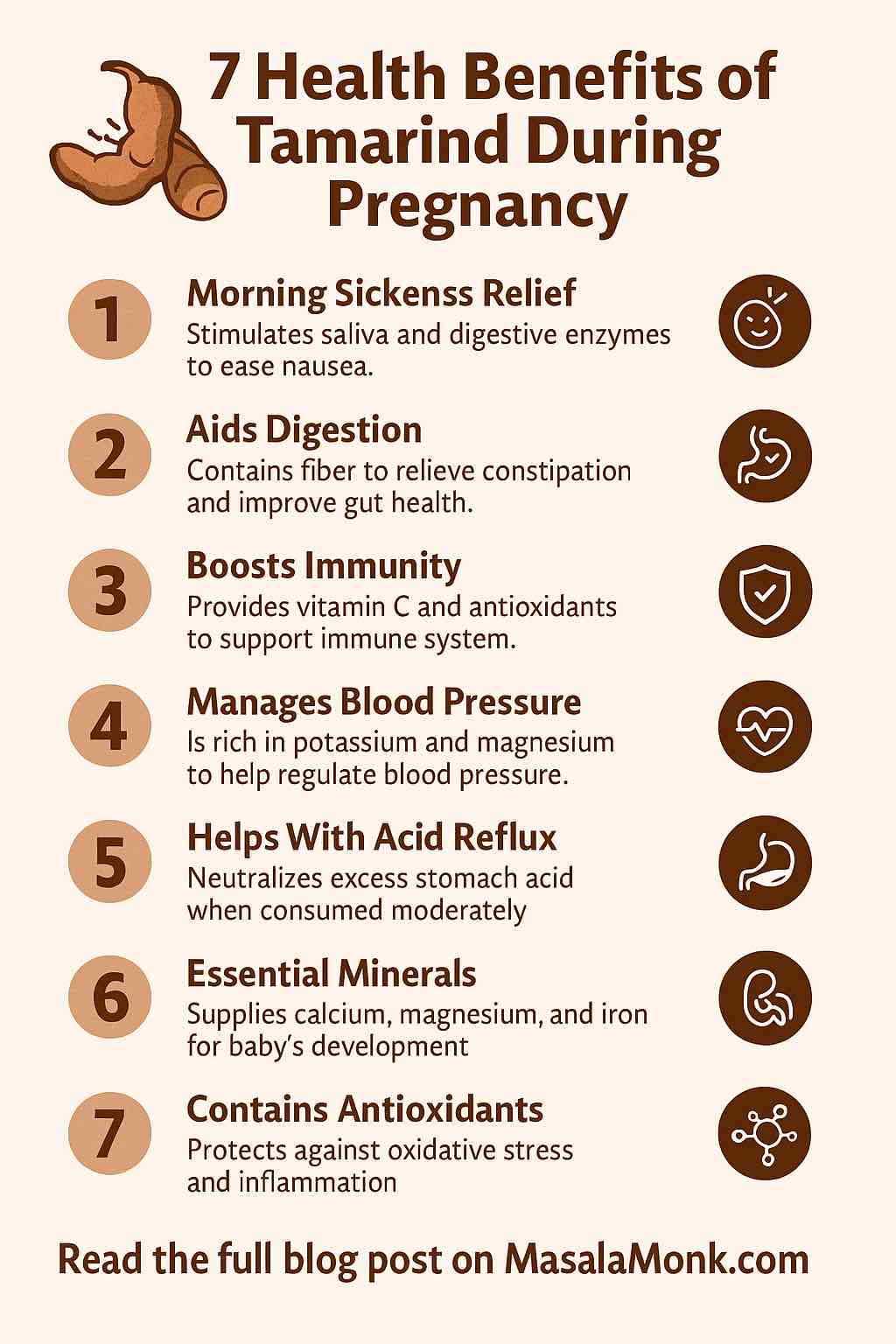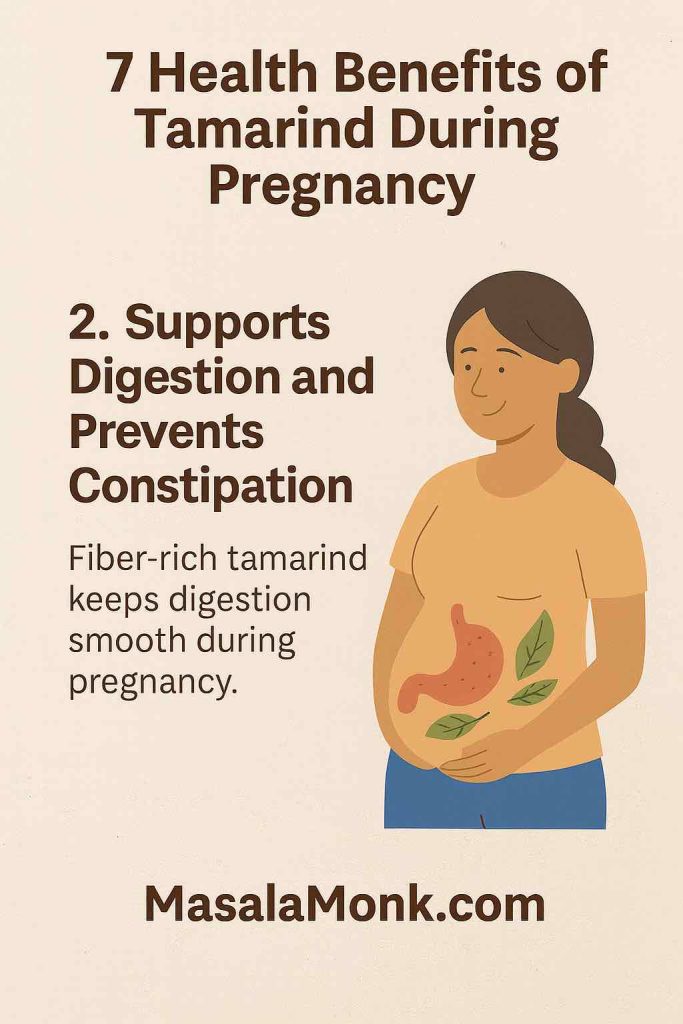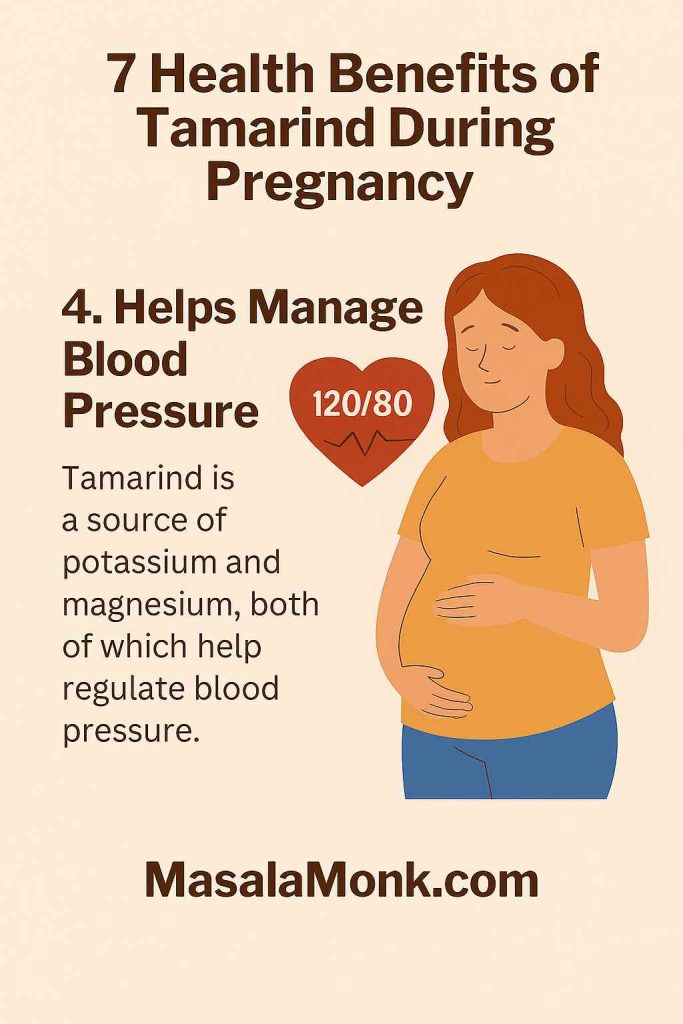
Pregnancy is a special time when every bite counts, and naturally, mothers-to-be often wonder: “Is tamarind safe during pregnancy?” Known as imli in Hindi, tamarind is a beloved fruit across cultures for its sweet-sour flavor. Many women even crave tamarind in pregnancy, especially during the first trimester when taste preferences and morning sickness are at their peak.
Traditionally, tamarind has been valued for its ability to cool the body, improve digestion, and relieve nausea. Today, science confirms that tamarind contains vitamin C, antioxidants, fiber, magnesium, and potassium—nutrients that can support both mother and baby.
In this article, we’ll explore seven key benefits of tamarind during pregnancy, safety precautions, and practical ways to enjoy it in your daily meals.
1. Tamarind for Morning Sickness Relief During Pregnancy
Morning sickness affects nearly 70% of pregnant women. Tamarind, with its tangy flavor, can help reduce nausea by stimulating saliva and digestive enzymes.

For example, a refreshing tamarind water drink or a spoon of tamarind chutney can ease queasiness naturally. However, it is best consumed in moderation to avoid acidity.
👉 Explore more natural solutions in our guide on morning sickness remedies.
2. Tamarind Benefits for Digestion and Constipation Relief in Pregnancy
Pregnancy hormones often slow down digestion, which may lead to constipation. Tamarind is naturally rich in dietary fiber, which helps regulate bowel movements and improve gut health.

Moreover, its mild laxative properties can provide gentle relief without the use of harsh medicines. In addition, tamarind pulp has been traditionally used in Ayurveda to maintain digestive balance during pregnancy.
👉 Looking for more gut-friendly ideas? Explore our post on pregnancy-safe fiber foods.
3. Boosting Immunity with Tamarind in Pregnancy: Vitamin C Power
Vitamin C is vital for both mother and baby, as it supports immunity, tissue repair, and iron absorption. Tamarind contains a good amount of this nutrient, making it a natural immune booster.

For example, tamarind chutney with dates can not only enhance flavor but also provide antioxidants that fight free radicals. On the other hand, remember that vitamin C from whole foods works best when combined with a balanced diet.
💡 Learn more in our pregnancy nutrition essentials guide.
4. Helps Manage Blood Pressure
Tamarind is a source of potassium and magnesium, both of which help regulate blood pressure. During pregnancy, maintaining healthy blood pressure is crucial to prevent complications such as preeclampsia.

In addition, tamarind’s polyphenols may support vascular health, keeping the circulatory system strong. However, avoid tamarind candies with added salt, which can have the opposite effect.
5. Tamarind and Acid Reflux: Safe Natural Remedy in Pregnancy
Acidity and heartburn are common in pregnancy. Interestingly, a small amount of tamarind water can neutralize excess stomach acid and provide relief.

However, overconsumption may increase acidity due to tamarind’s sour profile. Therefore, moderation is key—just a few sips or a teaspoon of diluted pulp can be soothing.
Read More about Heartburn and Acid Reflux During Pregnancy
6. Tamarind Provides Essential Minerals for Baby’s Growth
It contains calcium, magnesium, and iron, which are important for fetal bone development, red blood cell production, and overall growth.

Moreover, tamarind enhances iron absorption from plant-based foods, which helps reduce the risk of anemia—a common concern in pregnancy. For instance, pairing tamarind-based dishes with lentils or spinach boosts nutritional value.
💡 Curious about why cravings shift? Read our detailed guide on pregnancy cravings.
7. Imli in Pregnancy: Antioxidants for Long-Term Maternal Health
Free radicals can cause oxidative stress, which is linked to pregnancy complications. Tamarind pulp is packed with antioxidants and polyphenols that protect both mother and baby.

In addition, these compounds may reduce inflammation and support metabolic health. For example, incorporating tamarind into homemade curries or chutneys adds both flavor and nutrition.
👉 Dive deeper into second trimester nutrition tips.
⚠️ Safety Precautions: Is Tamarind Safe During Pregnancy?
Yes, tamarind is generally safe during pregnancy—when eaten in moderation. However, there are a few things to keep in mind:
- Moderation is key → 5–10 grams of pulp a day is usually safe.
- Avoid excess acidity → Too much tamarind may trigger acid reflux.
- Be mindful of tamarind candies → These often contain added sugar and salt.
- Check with your doctor if you have diabetes or GERD, as tamarind may influence blood sugar or acidity levels.
Pairing inspiration: Check out our iron-rich pregnancy snacks and folate-focused recipes.
🍽️ Practical Ways to Include Tamarind in Pregnancy Diet
- Tamarind water – A refreshing way to ease nausea.
- Tamarind chutney – Pair with snacks or lentils.
- Curries and soups – Add depth of flavor and nutrition.
- Imli sharbat – A cooling summer drink (limit sugar).
Conclusion: Tamarind Benefits During Pregnancy in a Nutshell
Tamarind—whether called imli or tamarindo—is more than just a tangy craving during pregnancy. It provides fiber, vitamin C, antioxidants, and essential minerals that support digestion, immunity, and fetal development.
However, as with all foods in pregnancy, moderation is key. A small amount of tamarind in chutneys, curries, or refreshing drinks can safely deliver health benefits without unwanted side effects.
For more insights into superfoods that make pregnancy healthier, check out our post on 10 exotic superfoods for pregnancy.
👉 Want to learn more about pregnancy-friendly foods? Explore more wellness guides at MasalaMonk.com.
🌿 FAQs: Tamarind During Pregnancy
1. Is tamarind safe during pregnancy?
Yes, tamarind is generally safe during pregnancy when eaten in moderation (around 5–10 grams of pulp daily). However, excessive intake may cause acidity or affect blood sugar levels.
2. Why do pregnant women crave tamarind?
Many women crave tamarind in pregnancy due to hormonal changes and shifting taste preferences, especially during the first trimester. Tamarind’s tangy flavor also helps reduce nausea and morning sickness.
3. Can tamarind help with morning sickness?
Yes, tamarind can provide natural relief from nausea by stimulating saliva and improving digestion. A small amount of tamarind water or chutney can ease queasiness.
4. Does tamarind cause acidity in pregnancy?
Tamarind can both soothe and aggravate acidity. In small amounts, it may neutralize excess stomach acid. But overconsumption often worsens acid reflux and heartburn.
5. What nutrients does tamarind provide for pregnant women?
Tamarind contains vitamin C, antioxidants, calcium, magnesium, potassium, and iron—all essential for immunity, fetal growth, and overall pregnancy health.
6. Can tamarind help prevent constipation during pregnancy?
Yes. Tamarind is rich in dietary fiber, which supports digestion and regular bowel movements. Its mild laxative effect can ease constipation naturally.
7. Is imli good for baby’s development during pregnancy?
Yes, imli provides minerals like calcium, magnesium, and iron that support fetal bone development, red blood cell production, and overall growth.
8. Can tamarind lower blood pressure in pregnancy?
Tamarind is rich in potassium and magnesium, which may help regulate blood pressure. However, avoid salted tamarind candies, as they can raise blood pressure.
9. Are there risks of eating tamarind during pregnancy?
Yes, risks mainly arise from overconsumption—leading to acidity, low blood sugar, or excess calorie intake if eaten in candies with sugar and salt.
10. How can I include tamarind in a pregnancy-safe way?
You can enjoy tamarind water, chutneys, soups, or curries in moderation. Limit highly processed tamarind products and always balance with other nutrient-rich foods.










[…] 7 Health Benefits of Tamarind During Pregnancy, click here […]
[…] Also Read: 7 Health Benefits of Tamarind During Pregnancy […]
[…] 7 Health Benefits of Tamarind During Pregnancy, click here […]